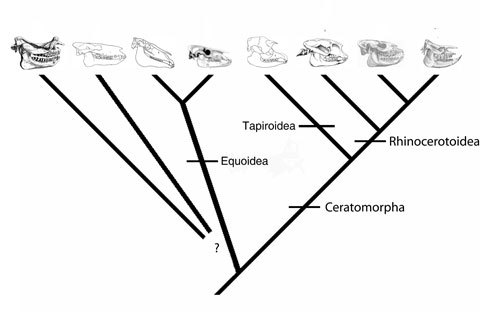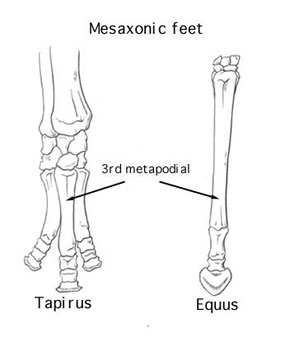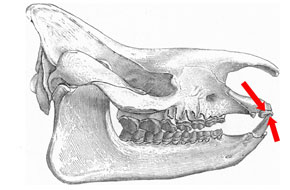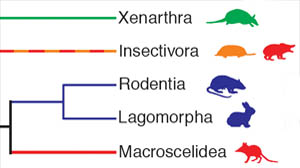Tree of Life
Tree of Life
All life is interrelated. Phylogenetic systematics is the branch of science that attempts to reconstruct the evolutionary relationships of species. One of the best ways to show the interrelationships of species is to use a tree-like branching diagram known as a cladogram. Groups of interrelated species that share a common ancestor are called clades. Reconstructing evolutionary trees is an important step in learning the evolutionary history of species. Cladograms give us a framework for understanding how groups of organisms evolved, how rapidly they evolved, and how their evolutionary history relates to the earth's changing climate and geography.

For instance, perissodactyls are a clade; all the perissodactyls share a common ancestor that is not shared with any non-perissodactyl species. All species descended from this ancestor belong to the perissodactyl clade. A clade can be part of a larger clade: for instance, perissodactyls belong to a much larger clade of animals, the Mammalia. Mammals share a very ancient common ancestor, and its descendents include all mammals that have ever existed, including perissodactyls. A clade can also contain smaller clades. There are several of these clades within the Perissodactyla. For instance, rhinos belong to a clade called the Family Rhinocerotidae. All rhinos share a common ancestor that is more recent than the common ancestor of perissodactyls.
You might think that the discovery and study of fossils would be important for finding the common ancestors of clades. However, only a small number of all the species that ever existed are preserved as fossils. Therefore, through simple probability, it is unlikely that the long-extinct ancestors of many clades were preserved. However, even though we never discover the common ancestors of most clades, we can often develop an approximation of what the common ancestor was like.
We know that all the members of a clade descend from the common ancestor of that clade. It follows that any character shared by all of the members of the clade will probably be a character that was possessed by the common ancestor. It also follows that the earliest members of each of the major sub-clades within our group will look more like the common ancestor than the later, more advanced forms.
For instance, we don’t know what the ancestral perissodactyl looked like, but the fossil record of early perissodactyls is quite good. In the early Eocene, about 55 million years ago, are found abundant remains of these animals. The fossils suggest that the ancestral perissodactyl was small, with relatively simple dentition, four toes on the front foot and three toes on the hindfoot. The exact ancestor of perissodactyls is unlikely to ever be discovered, but we can still recognize the common ancestry of its descendents through shared traits that were inherited from this ancestor.
The evolutionary relationships of living and extinct species are traditionally recognized by comparisons of morphology. Morphology is similar to anatomy; it is the study of shapes and arrangement of parts of organisms in terms of such general principles as evolutionary relations, function, and development. Clades are discovered and defined by special similarities known as homologies. Homologies are characters, such as morphological features, that are shared by all members of a clade because they were inherited from the common ancestor of the clade. For instance, all mammals have hair and are warm blooded. This suggests that the common ancestor of mammals had hair and was warm blooded. Perissodactyls have a mesaxonic foot and a unique ankle joint, where two of the ankle bones (the astragalus and the navicular) are articulated via a saddle-shaped joint. (See image 1.) Finally, the rhino clade is united by a specialized pair of upper and lower incisors, where the lower incisor is tusk-like and sharpens on a chisel-like upper incisor. (See image 2.)
Over the last few decades, scientists have begun to use genetic similarities in addition to morphology to help determine the relationships of living species. We still have to use morphology to study fossil species and their relationships to living species, because fossils don’t preserve genetic evidence. However, we can use computer programs to resolve evolutionary relationships and generate cladograms based on large datasets of morphological and genetic characters of species. To see two such cladograms for the mammal clade, click on the cladogram excerpt on the right.
The perissodactyl cladogram that can be seen here is based on morphological similarities or living and extinct species and is also supported by genetic data from the living species. There is enough data, both morphological and genetic, to conclude that rhinos and tapirs are closely related and belong in a sub-clade called Ceratomorpha. Horses are more distantly related to tapirs and rhinos and belong to another sub-clade of the Perissodactyla known as the Hippomorpha. There are several other extinct families of perissodactyls that share homologies with rhinos or tapirs and belong within the ceratomorph clade, while others are more closely related to horses. The exact relationships of two families of perissodactyls, Brontotheriidae and Chalicotheriidae, are uncertain. Different analyses of phylogenetic data give conflicting results as to their position, so they are positioned at the bottom of the perissodactyl clade with a "?'" to signify this ambiguity. These two families possess the characteristics that include them in the perissodactyl clade, but their exact position within the Perissodactyla is unresolved. More detailed study of their fossils are needed to provide data to resolve these relationships.



